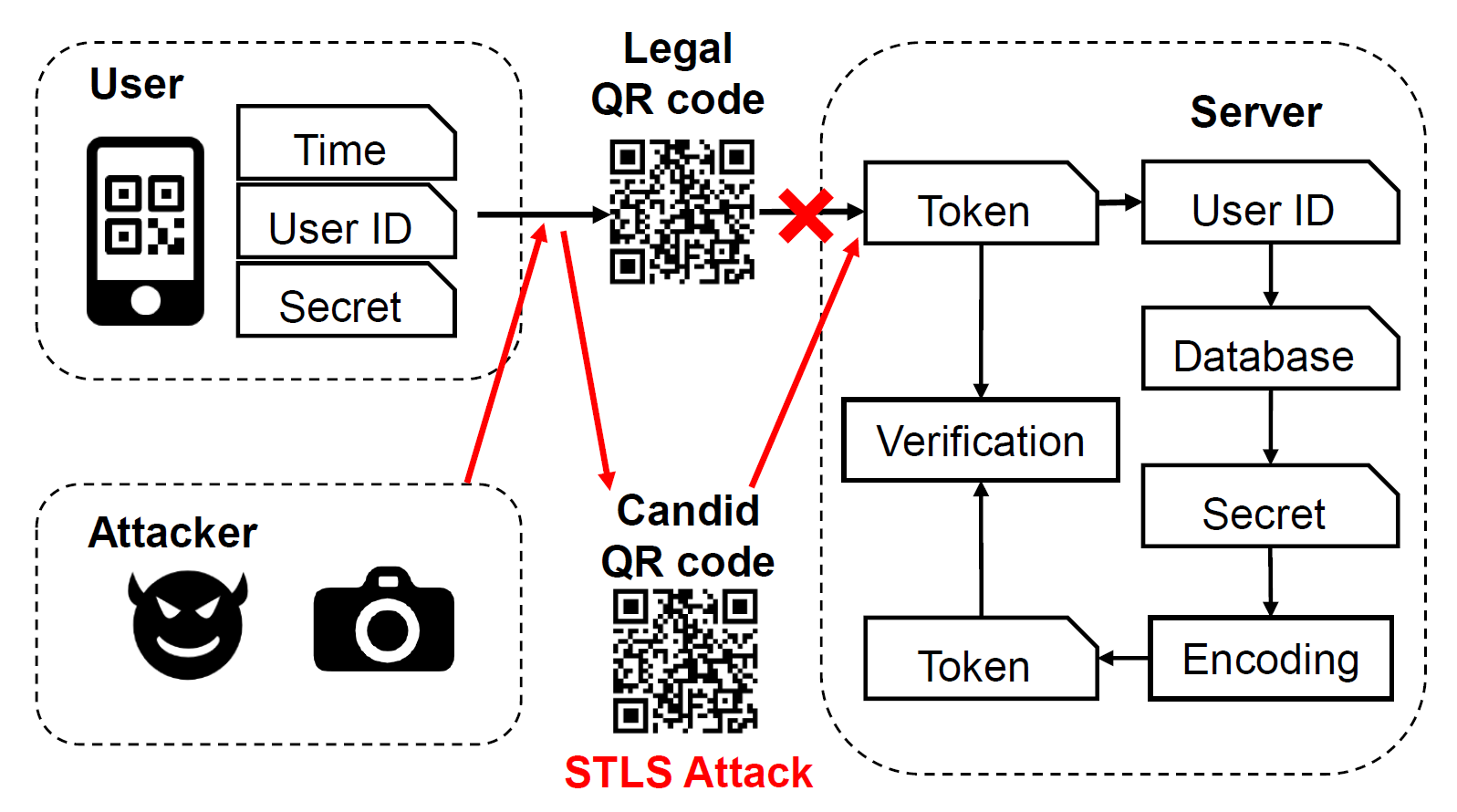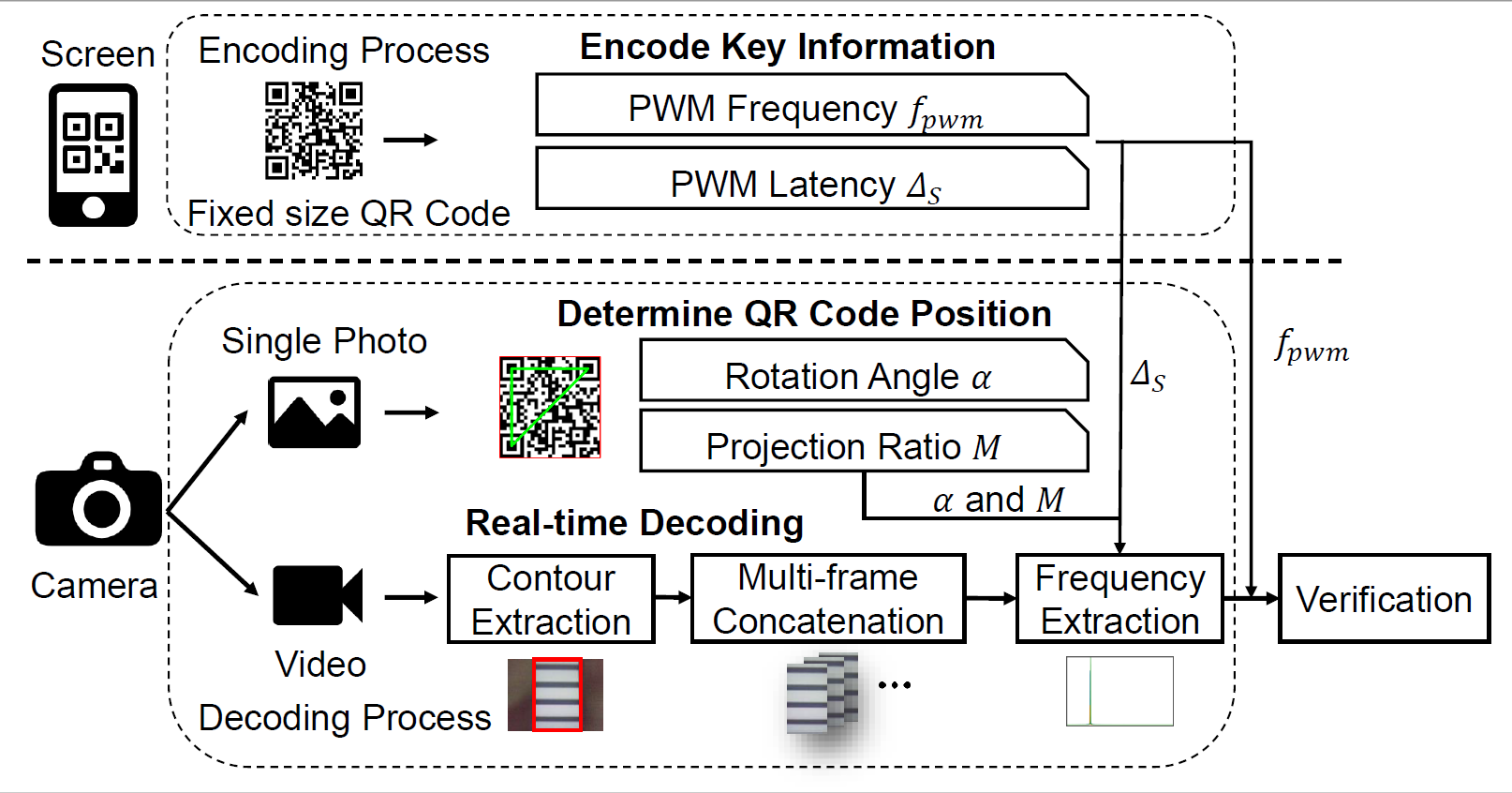Enhancing QRCode Security by Fingerprinting Screens
Guangtao Xue 1 , Jiadi Yu 1
Zhejiang University 2
Abstract
Quick response (QR) codes have been widely used in mobile applications due to its convenience and the pervasive built-in cameras on smartphones. Recently, however, attacks against QR codes have been reported that attackers can capture a QR code of the victim and replay it to achieve a fraudulent transaction or intercept private information, just before the original QR code is scanned.
In this study, we enhance the security of a QR code by identifying its authenticity. We propose ScreenID, which embeds a QR code with information of the screen which displays it, thereby the QR code can reveal whether it is reproduced by an adversary or not. In ScreenID, PWM frequency of screens is exploited as the unique screen fingerprint. To improve the estimation accuracy of PWM frequency, ScreenID incorporates a model for the interaction between the camera and screen in the temporal and spatial domains. Extensive experiments demonstrate that ScreenID can differentiate screens of different models, types, and manufacturers, thus improve the security of QR codes.
Introduction
The QRCode system works in a straightforward way. As shown
in the flowchart in Fig.1, payment transactions begin
with the generation of a legal QR code, which includes the ID of the user in the application, e.g., the AliPay account, a time-stamp, and the secret transaction information in the form of an encrypted token. The user then presents the QR code to the cashier to have it scanned into the transaction system, together with other transaction information such as total amount and currency type. On the server side, the merchant extracts the token from QR code, obtains the user ID from the token and then accesses the database maintained by the company to retrieve the stored secret of the payer. This secret is then converted into a new token for verification. As long as the token is deemed valid, the transaction proceeds.

However, the above-mentioned transaction process is far from secure. Recently, researchers have reported that a QRCode system is susceptible to the Synchronized Token Lifting and Spending (STLS) attack and other similar attacks 1. In this attack, the adversary first acquires an image of the QR code displayed on the victim’s device, when the victim is showing the QR code to the cashier, then the adversary replays the stolen QR code for another transaction, which we call fraudulent transaction. To ensure the success of such an attack, the adversary should also finish the transaction before the legitimate scanning process from the cashier.
To address this issue, we sought to enhance the security of the QRCode system by identifying the authenticity of a QR code. We propose ScreenID, which embeds a QR code with information of the screen that is displaying it, thereby the generated QR code can reveal whether the screen is corresponding to it. In ScreenID, we utilize the pulse width modulation (PWM) frequency of screens as the unique screen fingerprint. PWM frequency makes a good candidate for screen fingerprint for the reason that it is adjusted to different value by screen manufacturers. Even for the same manufacture, the PWM frequency shows variances due to the variations in the manufacturing processes.
Fig.2(a)(c)(e) shows the black and white bands caused by
the interaction between LCD screen flicker and the rolling shutter. Note the
lack of variation in the width and angle of the bands despite variations in the
distance and angle between the camera and screen. This indicates the
estimates of flicker frequency vary only as a function of rolling shutter
speed. By contrast, the bands in Fig.2(b)(d)(f) from an OLED
screen varied in terms of width and angle, depending on the position of the
screen. This can be attributed to the fact that each pixel in an OLED screen is
controlled by an LED light source and the PWM cycle of each row is
asynchronous.

Therefore, the key idea of ScreenID is to model the screen-camera interaction in temporal as well as spatial domain. The system needs to parse out the PWM frequency of the screen from the captured picture regardless of any rotation angle and capturing distance. Fig. 3 illustrates the architecture of ScreenID system, comprising two parts: encoding by the sender (smartphone screen) and decoding by the receiver (camera). For decoding process, the system first captured a single image to determine QR code position, then captured a video for real-time PWM frequency extraction. The frequency extraction process includes four steps: contour extraction, multi-frame concatenation, frequency extraction and verification.

Contribution
We verified the efficacy of a ScreenID prototype using 50 screens under a variety of camera settings and environmental conditions. The usability of the proposed system was also verified in experiments involving ten participants of various ages. We summarize the contribution as follows:
- We demonstrated the feasibility of using PWM frequency of screens for fingerprint, and the fingerprint can be embedded in to a QR code to check its authenticity. From our dataset, $99.3\%$ pairwise frequency differences of screens are larger than $0.1Hz$.
-
We proposed ScreenID, which incurs no additional hardware for the QRCode system and has no requirements for user behavior. ScreenID can be implemented via a simple software update.
-
We proposed to model the interaction between the camera and the screen in both temporal and spatial domains and achieved high estimation accuracy of PWM frequency, i.e., within $0.03Hz$
- We conducted exhaustive experiments and demonstrated the efficacy of the ScreenID system under a variety of operating conditions. The evaluation shows the identifiable success rate (i.e. True Positive Rate) is above $94.3\%$ and the wrongly accepted rate (i.e. False Positive Rate) against attack attempts is below $0.8\%$.
Demo Video
The video of the full presentation: